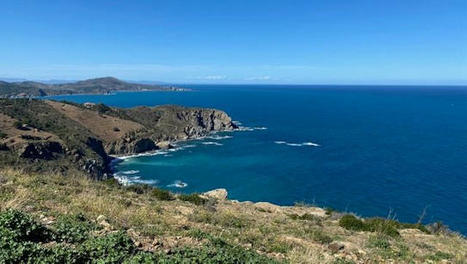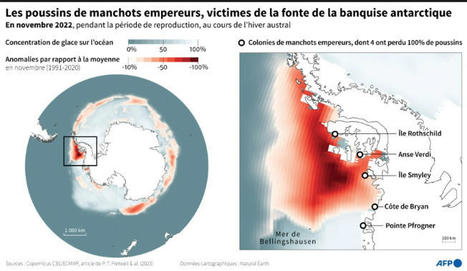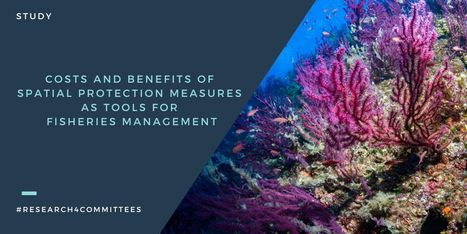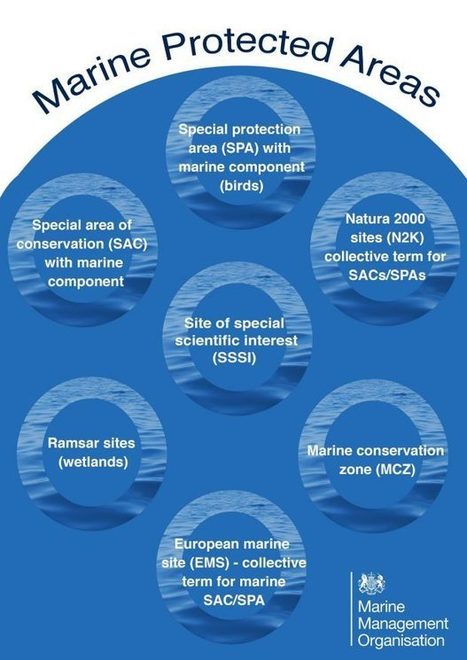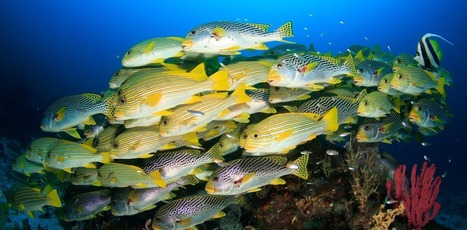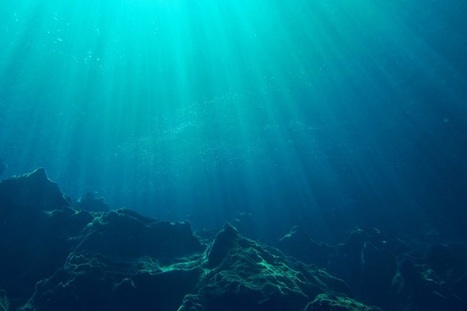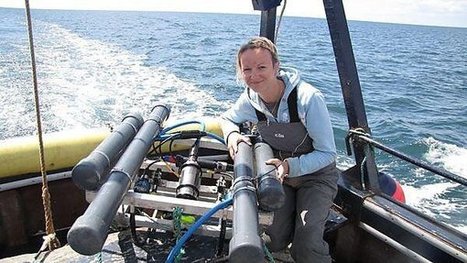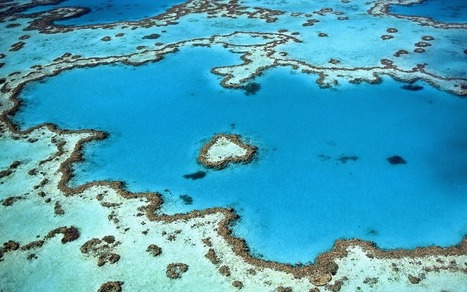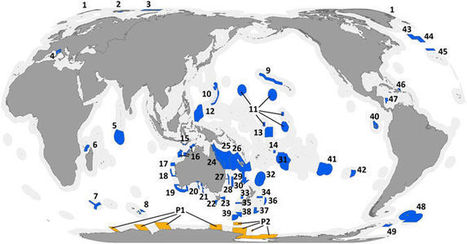 Your new post is loading...
 Your new post is loading...

|
Scooped by
DocBiodiv
|
L’un des principaux outils de protection de la biodiversité, ce sont les aires marines protégées. La réserve marine de Cerbère-Banyuls, dans les Pyrénées-Orientales, est l'une des plus exemplaires.
La Commission pour la conservation de la faune et la flore marines de l'Antarctique, qui regroupe 26 pays et l'UE, a échoué à trouver un accord pour instaurer de nouvelles aires marines protégées, malgré la fonte accélérée des glaces autour du pôle Sud, ont annoncé vendredi des ONG de défense de l'environnement.
Via Hubert MESSMER

|
Scooped by
DocBiodiv
|
The objective of this study is to evaluate the concrete costs and benefits of three types of protected areas within the marine environment: (i) Fish Stock Recovery Areas (FSRAs), (ii) Marine Protected Areas (MPAs), and (iii) areas designated as Other Effective area-based Conservation Measures (OECMs). There is evidence that FSRAs, MPAs and OECMs provide economic benefits to fisheries and aquaculture sectors in Europe.

|
Scooped by
DocBiodiv
|
Les Etats parties se réuniront pendant dix jours (en virtuel), pour parler gestion de la faune, de la flore et des 52 bases scientifiques du continent le plus austral de la planète.

|
Scooped by
DocBiodiv
|
In the face of intense human pressure on European seas, a network of well-managed marine protected areas (MPAs) is critical for marine biodiversity protection. In 2018, the EU (including, at the time, the United Kingdom) declared having met international targets for marine conservation, by designating more than 10% of its waters as MPAs. However, this declaration of success ignored the fact that designation is just one step towards achieving real protection. Without effective management, designated MPAs remain mere ‘paper parks’ that provide little to no actual protection.

|
Scooped by
DocBiodiv
|
The management of our coastal waters plays an important role in protecting and conserving our marine ecosystems. The Marine Conservation Team at the MMO are responsible for the implementation of management in certain marine protected areas (MPA) in English waters. We will be writing a series of blog posts explaining what and how we manage these MPAs, starting at the beginning, with what is an MPA?

|
Scooped by
DocBiodiv
|
Marine protected areas, or MPAs as they’re more commonly called, are very simple. Areas of the sea are set aside where certain activities – usually fishing – are banned or restricted. Ideally, these MPAs might be placed around particularly vibrant habitats that support lots of different species, like seagrass beds or coral reefs. By preventing fishing gear such as towed seabed trawls from sweeping through these environments, the hope is that marine life will be allowed to recover. When used well, they can be very effective.

|
Scooped by
DocBiodiv
|
Review recommends introduction of Highly Protected Marine Areas as essential for marine protection and recovery. An independent review led by former Fisheries Minister Richard Benyon, and published today on World Ocean Day, is calling for the introduction of Highly Protected Marine Areas in English waters. The review was commissioned on last year’s world ocean day by then Environment Secretary Michael Gove as part of the Government’s drive to protect our waters. These highly protected marine areas would enable a greater recovery of the marine ecosystem and enhance the Government’s commitment to a national ‘Blue Belt’, which has already seen an area of 92,000 square km protected - 40% of English seas.

|
Scooped by
DocBiodiv
|
Researchers from the University of Plymouth have contributed to a new book addressing some of the most pressing challenges in marine conservation.

|
Scooped by
DocBiodiv
|
Avant d’initier la révision de la stratégie de création et de gestion des AMP pour 2020-2030 que La France présentera lors du congrès mondial de la nature organisé par l’UICN en 2020 à Marseille, le Ministère de la Transition écologique et solidaire a demandé un bilan évaluatif des résultats obtenus de la stratégie nationale AMP.
Cette évaluation a été coordonnée par l’AFB et réalisée par le groupement de bureaux d’étude ACTeon/MC2/Creocéan/Mickaël Dupré, avec l’appui du comité français de l’UICN. Elle comprend : -Un état des lieux du réseau d’AMP françaises en 2019 au regard de la SCGAMP de 2012 ; -L’analyse comparée d’autres stratégies nationales en matière d’AMP ; -Un travail de consultation des parties prenantes.

|
Scooped by
DocBiodiv
|
Les attendus du Colloque Un ensemble de propositions co-construites par les participants qui alimenteront les volets stratégiques et opérationnels de la nouvelle stratégie. Forum des solutions En vue de nourrir les ateliers de production sur le futur cadre opérationnel, ce Forum a pour but d’informer et de partager avec l’ensemble des participants des retours d’expérience mises en oeuvre concrètement dans les AMP analysant les succès et les échecs autours des 5 enjeux de la future stratégie.

|
Scooped by
DocBiodiv
|
Designating protected areas is relatively easy, but hardly anyone seems to be bothering with the hard work of actually protecting them.
Les aires terrestres protégées font-elles assez pour la biodiversité? Probablement pas, estiment des chercheurs dans la revue Nature. Selon leur étude, elles pourraient grandement gagner en efficacité, en allant au-delà du seul critère de la diversité en espèces.
Via Pescalune
|

|
Scooped by
DocBiodiv
|
Marine Protected Areas (MPAs) demonstrate promise for increasing ecosystem resilience and reversing habitat and population declines, but outcomes vary considerably from context to context. Partially protected areas offer a compromise between ecological recovery and the social needs of local communities, but their success is contingent on an array of factors.

|
Scooped by
DocBiodiv
|
Il s’agit d’un forum mondial qui réunit des professionnels de la conservation des océans et des fonctionnaires de haut niveau pour enrichir les connaissances concernant les aires marines protégées, ainsi que donner des idées et prendre des mesures en ce sens.

|
Scooped by
DocBiodiv
|
Marine mammals play a crucial role in marine ecosystem function and climate change resilience by sequestering carbon through the consumption of energy rich plankton and fish. They provide valuable ecosystem services such as ecotourism. Conserving marine mammals provides significant economic, social and cultural benefits to coastal communities.

|
Scooped by
DocBiodiv
|
A healthy Ocean is critical for achieving sustainable development goals but the Ocean is threatened by multiple stressors. There is a global call to increase the coverage of marine protected areas (MPAs) from 10% to at least 30% by 2030. France, a major actor for marine conservation with the second largest exclusive economic zone (EEZ) in the world, with territories in all Ocean basins but the Arctic, aims at reaching the 30% by 2022, for which one third shall include a strong protection status. However, the strategy to reach this twofold target faces two challenges. First, while some standards exist to classify the levels of protection, France is currently using a case specific, loose approach to define strong protection. Second, there is no criteria that addresses the representativeness of the protection across French Ocean basins. Here, we assess the protection levels of the 524 French MPAs and their distribution across territories and habitats. While 33.7% of France’s waters are covered by an MPA, 12.5% of these areas do not impose regulations stronger inside than outside. Full and high levels of protection, the most effective for biodiversity conservation, represent only 1.6% of French waters and are unevenly distributed across Ocean basins and habitats, with 80.5% concentrated in a single territory.

|
Scooped by
DocBiodiv
|
Nous avons constaté qu'en dépit du cadre mis en place pour protéger le milieu marin, les actions de l'UE n'avaient pas permis de rétablir le bon état écologique des mers, ni d'y ramener partout la pêche à des niveaux durables: ce constat recoupe celui dressé par l'Agence européenne pour l'environnement dans un rapport publié alors que nous achevions nos travaux d'audit, selon lequel la biodiversité marine reste menacée dans les mers européennes. De nombreuses évaluations des espèces et des habitats marins continuent de révéler un état de conservation «défavorable», voire «inconnu». Si nous avons pu établir que l'action de l'UE avait abouti à des progrès sensibles dans l'Atlantique, la Méditerranée est quant à elle restée largement surexploitée; par ailleurs, seule une petite partie du Fonds européen pour les affaires maritimes et la pêche a été utilisée pour financer la conservation du milieu marin.

|
Scooped by
DocBiodiv
|
We will take a closer look at some of the issues of addressing plastic pollution in Marine Protected Areas, through a number of case studies across Europe. The session will bring together EU policy makers, European MPA managers, representatives from the private sector, and other stakeholders, to discuss the challenges and potential ways forward.

|
Scooped by
DocBiodiv
|
Tropical coral reefs are subject to multiple pressures from both natural and anthropogenic sources. These pressures have caused widespread declines in reef health, resulting in the increased use of spatial management tools such as marine protected areas (MPAs). MPAs have proven generally effective if well designed and enforced, but there are limited long-term studies investigating how the presence of small-scale MPAs affects fish populations and reef communities. Using a 12-year time series, we found that small-scale (10–50 ha) community-managed MPAs along the Danajon Bank of the Philippines preserved average fish biomass within their boundaries over time relative to surrounding fished reefs. Unprotected areas are, however, showing significant long-term biomass decline. MPAs were also found to preserve more key trophic groups and larger-bodied commercially targeted reef fish families.

|
Scooped by
DocBiodiv
|
new agreement is being negotiated under the 1982 United Nations Convention on the Law of the Sea (UNCLOS) to provide legally binding mechanisms to protect the marine environment and to conserve and ensure the sustainable use of marine biodiversity on the high seas (international waters in areas beyond national jurisdiction) (1). One of the suggested objectives in the current draft text is to “apply an approach that builds ecosystem resilience to the adverse effects of climate change” when applying area-based management tools (ABMTs), including marine protected areas (MPAs).

|
Scooped by
DocBiodiv
|
One-sixth of the global terrestrial surface now falls within protected areas (PAs), making it essential to understand how far they mitigate the increasing pressures on nature which characterize the Anthropocene. In by far the largest analysis of this question to date and not restricted to forested PAs, we compiled data from 12,315 PAs across 152 countries to investigate their ability to reduce human pressure and how this varies with socioeconomic and management circumstances. While many PAs show positive outcomes, strikingly we find that compared with matched unprotected areas, PAs have on average not reduced a compound index of pressure change over the past 15 y.

|
Scooped by
DocBiodiv
|
Discover the world's protected areas using the World Database on Protected Areas. Graphiques montant l'atteinte de l'objectif 11 global puis choix par pays.

|
Scooped by
DocBiodiv
|
Global areal protection targets have driven a dramatic expansion of the marine protected area (MPA) estate. We analyzed how cost‐effective global MPA expansion has been since the inception of the first global target (set in 1982) in achieving ecoregional representation. By comparing spatial patterns of MPA expansion against optimal MPA estates using the same expansion rates, we show the current MPA estate is both expensive and ineffective. Although the number of ecoregions represented tripled and 12.7% of national waters was protected, 61% of ecoregions and 81% of countries are not 10% protected. Only 10.3% of the national waters of the world would be sufficient to protect 10% of each ecoregion if MPA growth since 1982 strategically targeted underrepresented ecoregions.

|
Scooped by
DocBiodiv
|
Large marine protected areas (>30,000 km2) have a high profile in marine conservation, yet their contribution to conservation is contested. Assessing the overlap of large marine protected areas with 14,172 species, we found large marine protected areas cover 4.4% of the ocean and at least some portion of the range of 83.3% of the species assessed. Of all species within large marine protected areas, 26.9% had at least 10% of their range represented, and this was projected to increase to 40.1% in 2100.
|
 Your new post is loading...
Your new post is loading...
 Your new post is loading...
Your new post is loading...




